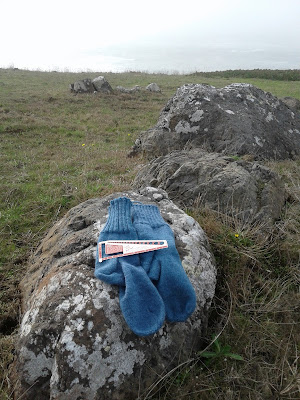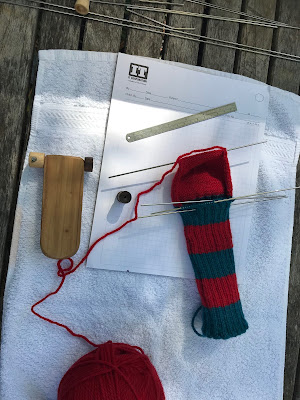Time to upgrade socks
The right socks for the coming storm.
Blunt 9" US1 needles using commercial worsted weight yarn.
Anything that can be made, can be made better! Anything that can be done, can be done better!
I believe in those two principles. I also believe that everything is a compromise. Doing something better, or making something better may not be worth the resources. "Good enough" may be good enough! Knitting is a prime example. Knitting is a group of compromises that I have not addressed in this blog since September 2016.
If I knit a fine weatherproof fisherman's sweater from a 5-ply "gansey" yarn that I spin from raw fleece; scouring the fleece and spinning the yarn is only perhaps 3 days work, while the knitting takes 3 or 4 times as long as making the yarn. If want my sweater faster, I should focus on faster knitting. I did.
The paths to faster knitting are thicker yarns, looser fabric, and - knitting faster. I like fine, firmly knit fabrics. If I want a cooler garment, I will knit it (firmly) from a thinner yarn. Thus, I focus on faster knitting.
To reprise, a long time ago, I learned to knit "American", on SPN; then friends said I could knit faster if I learned to knit "continental"; and, faster still if I moved on to circular needles. I wore out several sets of circular needles. I read about how fast the old professional knitters knit, and moved on to knitting belts and knitting sheaths. These were faster than circular needles, and allowed making fabrics that cannot be knit on hand-held needles - and specifically cannot be knit on circular needles.
Knitting belts remain as part of older knitting traditions that have survived to the present day, and we have a good understanding of the technology. We know that knitting belts are best used with DPN.
Knitting sheaths did not survive as an active knitting tradition, so I had to reinvent the whole technology. At first, I thought that knitting sheaths were just an wooden (or metal or ivory or ceramic . . .) analogue of knitting belts. My early tries told me that knitting sheaths had real advantages. They allow knitting very fast, producing very tight fabrics, and knitting with a minimum of effort in a very ergonomic manner. These advantages were very apparent in my early, crude attempts.
Since knitting belts use DPN, I assumed that knitting sheaths also used DPN, and all of my early trials used DPN with various pointy ends. I put a lot of effort into making pointy needles, and making the pointy needles work with knitting sheaths was a lot more effort. For years, the idea that knitting required pointy needles was fixed in my head. Years after I started working with knitting sheaths, I started considering "swaving", where a curved needle is rotated into the working stitch. I thought, "Wow, this is something else!", and went into it with fewer preconceived notions.
I made curved, pointy, needles and they did not work. I made a lot of different shapes of bent pointy needles and none of them worked. After much trial, and many errors, it became clear that blunt or even flat ended swaving needles worked very well. Then, my knitting sheaths had to be redesigned to work with flat tipped needles. None of this came fast. It was years of benchmarking and validating.
Swaving involves "popping" the working needle into the working stitch. Could I do the same thing with long straight needles? Yes!, but the knitting needle needs to be blunt or flat ended. It turns out to be easier and faster than poking pointy needles into the working stitch. Are flat ended needles authentic? Everybody that has acquired many old steel needles has come up with flat ended needles. Were they were just old pieces of wire that had found their way into the knitting basket? Now, I think that some (or many) of those flat ended needles survived from the days of knitting sheaths. And, we have an account of a professional knitter in the 1840s where in he makes a new knitting "needle" from a piece of wire in a few minutes by grinding it against a stone in the garden path. I can tell you that it takes hours to grind a pointy DPN like that, but flat ended needles can be ground like that in a few minutes. No, it is pretty clear that those old knitting pins had flat ends.
The bottom line is that having made and used thousands of different needles and hundreds of different knitting sheaths, I have settled on knitting/swaving with blunt or flat ended needles.
Fisherman's sweater on blunt 12" US#1 needles from
handspun 4-ply (~1,000 ypp) with knitting sheath/needle adapter
(the curved needles are for swaving)
Sock on blunt 12" by 1.5mm blunt needles from
6-ply cabled worsted wool yarn (3x2) at ~ 1,700 ypp
Sock on blunt 9" US#0 needles from
Paton's Classic Wool (204 meters/100 gr.)
"Needle" tips typical of what I have been making and using for knitting and swaving for the last few few years.






.jpg)
1 comment:
I am fascinated by knitting sheaths. I just started with a belt, and have seen what advantages there are to knitting "American".
My problem is in carving the sheaths. Is there a specific one to start with? I have made one out of an old aluminum knitting needle with a cut-off head. Stuffed that with some alpaca fiber. That works quite well for a beginning idea.I do have some filbert trimmings that would work great. There are some curves in several of the pieces. I am off on Sunday to have a friend drill holes in a few. She has made a really nice hackle so has a great drillpress.
Thank you for your in-depth research into this amazing technique. We are developing a group up here to use belts, and hopefully, sheaths as well.
Post a Comment